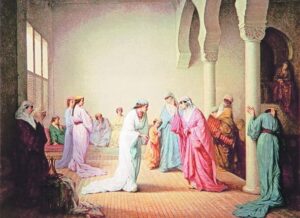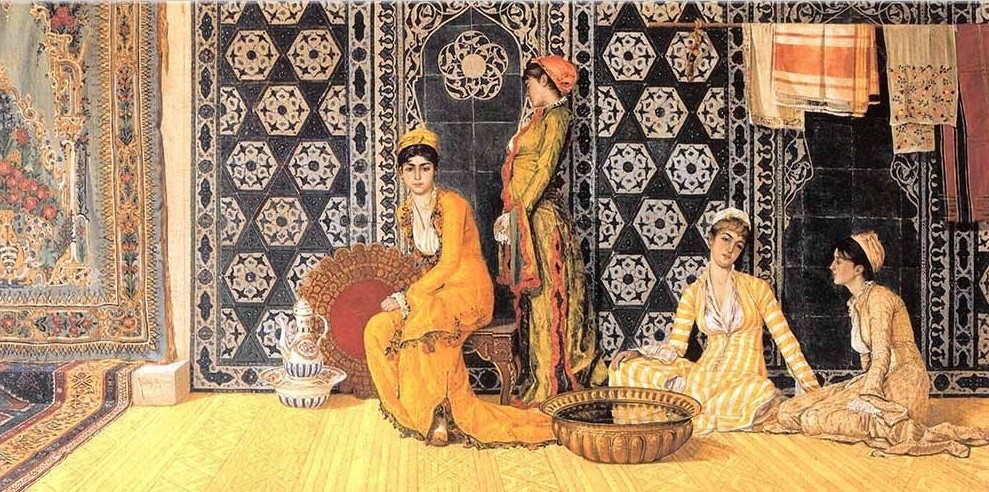By Nusrat Sidiq, Daily Sabah, 22, March 2021.
Many female figures throughout Islamic history have been admired for their lives, knowledge and morals. A biographical work from Ottoman literature, ‘Meşahirü’n-nisa,’ illuminates the stories of 1,165 renowned figures among them
International Women’s Day, marked on March 8, emerged in the early 1900s as part of the socialist movement in the U.S. In time, feminist movements adopted this day, which was initially acknowledged as “International Working Women’s Day,” with the support of Soviet Russia in 1967. It was declared International Women’s Day with the acceptance of the United Nations in 1975.
The history of women’s movements, collected under three waves, manifested itself in various ways in every field from politics to art. Therefore, the issue of Islam and women comes to the fore frequently. It is also one of the frequently studied themes in the field of culture and art.
Novels, movies and series about famous women of Islamic history, especially of the Ottoman era, draw attention in Turkey. There are many highly respected female figures among the companions of the Prophet Muhammad. These friends, who are called companions, saw or met the prophet during his lifetime and followed and continued his path as Muslims. In Arab cinema, some productions have shed light on these women.
When we look at the Ottoman literature, a biographical study titled “Meşahirü’n-nisa,” stands out in this aspect. The work “Meşahirü’n-nisa,” which means famous women, contains the biographies of women that Islamic scholars have examined. Let’s take a look at this important publication and some famous women in Ottoman literature.
First works featuring women
In Islamic historiography, the texts about the biographies of people living in the same period or region, dealing with the same discipline and performing the same art is called “tabakat.” These books present relevant biographies of successive generations according to their chronological order. They feature tens of thousands of figures, especially poets, artists and scholars. This is where we initially meet famous women.
These works, which are unique to the Islamic world, started to be written about the first Muslims, so they developed parallel to the first century of Islam. In this deep-rooted tradition of work, we do not come across a special book written only for women. Although it is criticized that this situation arises from a sexist point of view, there is no such thing.

According to the Sunni understanding of Islam, the companions of the prophet are regarded as superior without exception. In addition, in some of these books, women’s biographies were collected in a special volume, while information about women was given under a special section in some others.
A versatile scholar
When we come to the 19th century, text types also begin to differ. Hacı Mehmed Zihni Efendi, one of the Ottoman scholars, wrote the first serious and detailed work on women’s biographies with his Turkish book titled “Meşahirü’n-nisa.”
Having received a good education, Mehmed Zihni took lessons from the highly quality teachers of the period both in Istanbul and Alexandria in Egypt. He started to work as a clerk and proofreader in Matbaa-i Amire, the first official printing house of the Ottoman Empire. After working here for 10 years, he was appointed as a teacher.
In those years, he taught Arabic and religious lessons in Galatasaray High School, which was called Galatasaray Mektebi Sultani (Galatasaray Imperial High School) or Lycee Imperial Ottoman de Galata-Seraï in French back then. Meanwhile, he chaired many commissions affiliated with the Ministry of Education and prepared textbooks. Zihni Efendi, who wrote many works from grammar to religious sciences, history and literature, was one of the versatile scholars of his era.

He was awarded by the state with outstanding achievement medals and also became known on international platforms. Some of his books were sent to the International Congress of Orientalists, convened in Stockholm in September 1889. The science of his works, as well as his services to the Arabic language and teaching, drew attention. Therefore, with the proposal of the congress, he was awarded a gold medal by the union between Sweden and Norway, which was officially the United Kingdoms of Sweden and Norway or the United Kingdoms back then. This medal is kept in the Galatasaray High School Museum.
Girls’ teacher
Mehmed Zihni Efendi also wrote the first female-specific version of the religious books called “ilmihal” (a concise manual of Islamic faith, worship and ethics) in Oriental literature. Even though there were similar books before that, the book he published under the name of “Hanımlar İlmihali” (“Ladies’ Ilmihal”) and “Kızlar Hocası” (“Girls’ Teacher”) attracted a lot of attention and were used as textbooks. The book has been published in different versions according to age groups.
Therefore, we can say that Zihni Efendi was one of the most important names among the late Ottoman intellectuals who gave importance to the education of women.
When it comes to his masterpiece on women, he published the previously mentioned book “Meşahirü’n-nisa” in 1878.

This book is a two-volume work that includes the biographies of 1,165 women famous in the fields of science, art, literature and politics in Islamic history. In the book, many women, including poets, singers, teachers and Sufis, are discussed in line with their different features and characteristics. There is a myriad of chapters such as “historian women,” “Islamic female jurists who are famous for their taqwa (being conscious and cognizant of God)”, “women who are famous for the beauty of their oratory and sermons,” “women known for their calligraphy or their knowledge of literature,” and even “women who are renowned for being the source of proverbs.” We also see female rulers and doctors.
The book of Zihni Efendi is aimed at achieving three goals. First, it presented women, who stand out in different arts, social, scientific and professional fields, not by their gender but according to what they do. Thus, it encouraged female students to use their potential like these women by improving their current talents.
As the second target, it offered portraits of women with high morals. Many women with good morals serve as outstanding figures to be role models. Its third goal is to inform its readers in areas such as history, religion and art.
According to whom according to what
According to Zihni Efendi, perceiving Islam as a religion consisting only of the Quran will lead you to wrong judgments. The life of the Prophet Muhammad is the realization of this holy book. In order to gain a full understanding, you should learn about both the prophet’s life and the Quran as a whole and examine the people and events in line with the conditions of the era.
According to Islam, superiority is determined not by gender but by the concept of taqwa. This expression derives from the Arabic word waqa, meaning to protect. It means to protect oneself from deeds that are clearly stated to be bad and even avoiding bad behavior and living in total righteousness.
Therefore, the understanding of people’s superiority or inferiority is considered proportional to people’s attention to their morals. In addition, men and women are complementary to each other and are like two parts of a whole. The evaluations in “Meşahirü’n-nisa” have been made according to this perspective.
Superior to millions of men
When we look at the lists of women in the book, we initially see women who are famous for being the wife of the Prophet Muhammad. Then the women who are his daughters and other relatives are written about in the book. And in the next chapter, the famous women of that era or history praised by the prophet are listed.
The first Muslim women of this period are also discussed in separate chapters. “Women who were tortured for being Muslims” or “women referred to in the Quran” are examples of these chapters. Considering the Islamophobic attacks today, perhaps the most interesting part is these biographies.

As Mehmed Zihni Efendi stated in the main title of the first chapter, the wives of the prophet are named “ümmahatu’l-mü’minin,” that is, the mothers of the Muslims. And it has been emphasized that these names are superior to millions of men.
When we look at the names of famous women in the book, we see that many of them have the names of the wives and daughters of the Prophet Muhammad or the names of the first Muslims. One of the most striking of these is Fatima al-Faqih, a female scholar from the 12th century, described under a special title. Fatima, the daughter of the famous Islamic lawyer Alaeddin Samarkandi, is known for her knowledge in the field of law, just like her father.
His father did not make any judgment on any subject without obtaining her opinion. Fatima, who was very careful with religious rules, had many suitors when the age of marriage came. However, there was a condition she wanted from the groom-to-be: writing what we call the best “scholia” on his father’s book. Scholia means the explanation of a book that shows the level of knowledge and mastery of the author on the subject. Thus, Fatima was able to sort out ignorant men, regardless of their wealth and power, while selecting her future husband.
On this condition, a competition between young scholars was started and dozens of books were written and presented to Fatima. However, none earned her father’s or her approval. After a while, a young scholar who was a student of her father named Alaeddin al-Kaşani wrote a book. Both Fatima and her father liked the book, and Alaeddin and Fatima were married. Alaeddin, who loved his wife very much, did not marry anyone else. Like his father-in-law, he asked Fatima about every issue and would not publish a text that she did not approve of.
Meşahirü’n-nisa, who shed light on the lives of Fatima and many similar women, also made a tremendous impact on the Islamic world. The book was translated into Persian by author Muhammad Hasan Han and published in Tehran.

